#montfalcó
Note
bon dia!! I'm moving to Catalunya this fall to be an English teacher's assistant and I'm so so excited to learn catalan and explore your beautiful country 💗 Do you have any recommendations for places or activities around the Lleida región? Moltes gràcies ☺️
Bon dia!
In Lleida (the city itself), the most iconic site to visit is the Seu Vella (old cathedral). It's a Medieval cathedral that was also used as a stronghold in war in the Early Modern Period. It's located on top of a hill, so there's great views of the whole city from there.

(Photo)
A natural place: the Congost de Mont-rebei (Mont-rebei Canyon). This is the river that is used as the administrative dividing line between Catalonia on East and Aragon in the West (La Franja). It's a very beautiful place, but I don't know what it's like now with the drought. There's a very nice walk near the La Pertusa chapel and in an excavated part of the rock walls so you can see the river. Many people also go kayaking or similar things but I don't know if there's enough water now. (For context, we're having a very bad drought, it has barely rained in 3 years and all the reservoirs are practically empty).
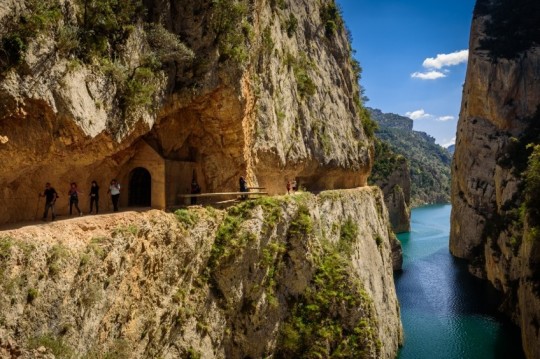
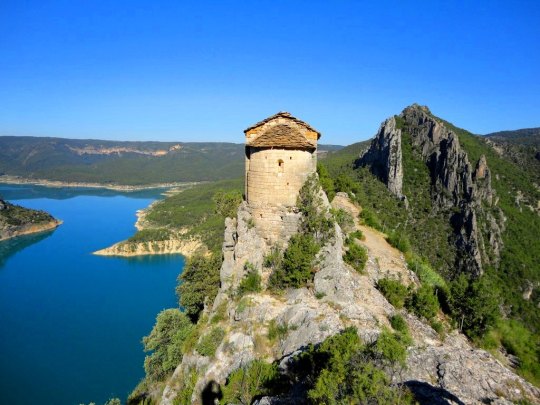
(Photo 1 / Photo 2)
In spring, it's also very pretty to see the fruit tree fields around Lleida. The most popular town to go to is Aitona, but you can also see it in Seròs, Alcarràs, Torres de Segre, and others.

(Photo)
Some historical small towns near Lleida that are nice to visit include Vallbona de les Monges with its Medieval monastery, and the towns around the Riucorb river (I would recommend the town Guimerà, and also Verdú to visit its tower), Montfalcó Murallat is also nice but very small. For a bigger town: Cervera. It's interesting to see the university building in Cervera, when Philip V (Spanish king who conquered Catalonia in 1714) made all the universities in Catalonia, Valencia, Mallorca and Aragon close down, he only allowed 1 university, which he moved to Cervera because it was a city where many people had supported him in the war and because it was in a rural area so he could closely control the students (university students in Barcelona and other places had been very involved in the war against Philip V).

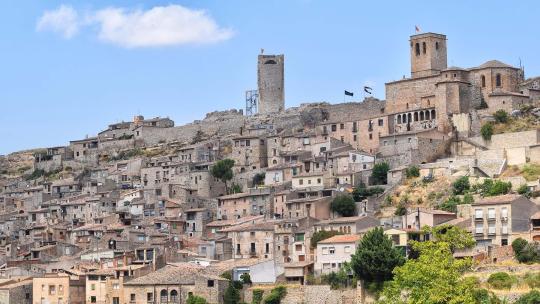
(Photo 1: Santa Maria de Vallbona monastery. Photo 2: Guimerà)
An archaeological site: Fortalesa dels Vilars in Arbeca. This was a fortress inhabited between 775 and 300 BC, you can visit the archaeological site and the museum with the objects found. Arbeca is also famous for its olives (called arbequines), definitively worth a try 😋🫒 you'll find them in most markets and supermarkets.
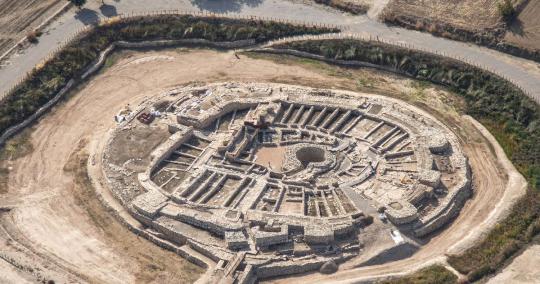
(Photo)
If you're near, when it comes to archaeology, there are also some prehistorical rock art sites. The most well-known in the area is the wall La roca dels moros in Cogul.

(Photo 1)
Those are the places I'd recommend closest to Lleida. If you can move more, I also really recommend going up to the Pyrenees mountains (in the north of the Lleida province). There's lots of Medieval architecture there, lots of cute villages and some wonderful natural parks.
The bad thing about the Lleida area is that it doesn't have as good public transport as more densely populated areas, because outside of Lleida city itself it's very rural. So you might have to rely on cars.
Another activity in Lleida: the most famous food from there is snails, there are different recipes, the most widespread is caragols a la llauna, but they also serve them with allioli or with vinaigrette. There's also many other delicious foods, but that is what most people associate with Lleida the most.
Aaand that's what comes to mind in the areas near Lleida. I'm not from that province so I don't know it as well as other areas, if someone reading this has more recommendations please feel free to add them in the reblogs or comments.
I hope you enjoy your time in Catalonia!
67 notes
·
View notes
Text



la Segarra, Tarragona, Lleida, landscape (2) (3) by Angela Llop
Via Flickr:
(1) Rellotge de sol, Florejacs, Lleida. Sundial.
(2) Interior del poble, Montfalcó murallat.
(3) Molí d'Albió, Segarra, Lleida. Sota el tossalet on hi ha el poble i vora el marge dret del riu Corb, hi ha el Molí d'Albió, construcció massissa datada al segle XIII.
Under the tossalet where the town is and along the right bank of the Corb river, there is the Molí d'Albió, a massive construction dating from the 13th century.
2 notes
·
View notes
Photo

Restaurant Montfalcó #comida #plato #salida #catalunya #reunion #family (en Restaurant Montfalcó) https://www.instagram.com/p/CoRuDwRs93V/?igshid=NGJjMDIxMWI=
0 notes
Photo
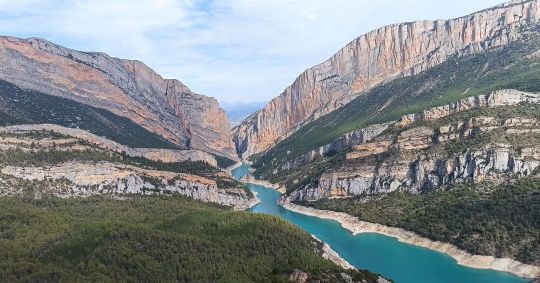
Jornada completa a les Passarel·les de #Montfalcó fins al #Congost de #Montrebei #Aragó (at Pasarelas De Montfalcó) https://www.instagram.com/p/CVD5rrasc_u/?utm_medium=tumblr
2 notes
·
View notes
Photo

Montfalcó - Spain (by Xavi)
#Montfalcó#Spain#Europe#Village#Old#Historic#Ancient#Photography#Architecture#Travelling#Traveling#Travel#Tourism#Vacation#Holiday#Urlaub#Reisen
2K notes
·
View notes
Text
A tale about bread and fishes

Montfalcó Murallat is a short distance from Cervera and very close to Les Oluges, another semi-fortified village on a hill. Access to the site by road is less than 10 km from the capital of la Segarra, ending in an ascent during which you can admire the compact but rather deteriorated enclosure of its walls of about eight metres in height.
In normal times, the fact that there is a coach park can be a little scary. In times of pandemic, the car park is likely to contain only three or four vehicles. The route around the village allows you to see where the interior has been restored and where it hasn't. The windows give it away. The ship shape of the enclosure is quite evident, and the rounding of the end where the bell tower of the church of Sant Pere rises is evidence of the existence of a sturdy apse inside, which took advantage of a tower of the fortification.
The entrance to the wall has the characteristics of a guardhouse where a direct attack could fail facing a small, highly compartmentalised redoubt. Immediately you come to a square where a restaurant, a few houses still in use and a rural tourism accommodation allow the village life to continue. It’s a quick walk. A couple more rural tourism establishments, another restored house and then back to the square. It is small in size.
Its origin probably dates back to the 11th century, when the Count of Berga incorporated part of the valley of the river Sió into the domains of his feudal lord, the Count of Cerdanya. Obviously, both territories were far apart, but the Reconquest was taking place at a fast pace.
Among the facts that speak of its strategic importance, and as an anecdote, there is talk of a siege of the castle in which the attackers decided to surrender it, leaving the occupants without food. As this had no effect, they decided to throw bread inside the castle over the fortifications of the walled village. The response came the same way. They threw fresh fish from the interior. As it became clear that surrender would be difficult, the siege was lifted.
Towards the end of the 11th century, control of the castle was in the hands of a probable Viscount of Berguedà called Dalmau Bernat. Later, in 1135, the Count of Barcelona - also of Cerdanya - Ramon Berenguer IV received tribute for the castle from another Viscount of Berguedà, Guillem, better known as a troubadour.
Guillem de Berguedà was not only famous for writing stories, but rather for being at the centre of many conflicts with other feudal lords - such as the Mataplana and Cardona families - and even with King Alfons, son of Ramon Berenguer IV and the first sovereign of the Catalan-Aragonese Crown. His violent death at the end of the 12th century was suspected of a revenge.
In the meantime, the possession fell to the Cervera family, lords of the nearby town. In 1234 it was already owned by the Cardona family, also viscounts, who took possession by adding it to the batllia of Torà. Later, the new owners would become counts and dukes, related to Castilian families, while the castle lost its importance until it was condemned by the confiscations of the 19th century.
2 notes
·
View notes
Photo

Pasarelas de Montfalcó at the Pantà de Canelles
#montfalcó#canelles#reservoir#hiking#landscapes#Serra del Montsec#bridge#path#pre-pyrenees#prepirineos#pyrenees#catalonia#aragon
2 notes
·
View notes
Photo
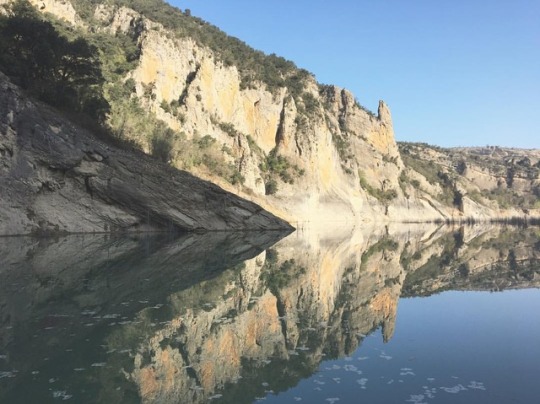
#congostdemontrebei • • • #montfalcó #ermita #corçà #ager #lanoguera #raconsde_lleida #raconsde_catalunya #paisatgesdecatalunya #descobreixcatalunya #descobreixlleida #somlleida #catalunya_monumental #catalunyagrafias #ermitesde_catalunya #world_sunsetsky #terresdelleida #montrebei #aralleida #aragon #pallars #total_monuments #total_catalunya #catalunyaexperience #igersaragon #trailadventure #trailrunner #catalunya #aventura #montsec (en Congost de Mont-rebei)
#paisatgesdecatalunya#corçà#igersaragon#montsec#raconsde_lleida#descobreixlleida#raconsde_catalunya#congostdemontrebei#terresdelleida#catalunyagrafias#total_catalunya#trailadventure#aragon#aventura#descobreixcatalunya#ermitesde_catalunya#montfalcó#lanoguera#pallars#montrebei#ager#ermita#world_sunsetsky#total_monuments#catalunya_monumental#catalunya#catalunyaexperience#trailrunner#aralleida#somlleida
0 notes
Photo

Montfalcó murallat by Som Segarra - Turisme La Segarra
2 notes
·
View notes
Photo

Montfalcó Murallat es una entidad de población del municipio de Olujas, en la comarca de la Segarra, provincia de Lérida, que se encuentra situado sobre la confluencia del Sió y de su afluente izquierda: la riera de Vergós. Esta antigua edificación consta de quince casas, construidas de forma compacta alrededor de una plaza donde confluyen las vertientes de los tejados, y la iglesia parroquial de San Pedro, haciendo de ella uno de los mejores ejemplos en Cataluña y España de villa amurallada, es decir, de población protegida por murallas, sin edificaciones extramuros. Es un tipo de población típica de la época antigua y de la edad medieval. / Montfalcó Murallat is a population entity of the municipality of Olujas, in the region of La Segarra, province of Lleida, which is located on the confluence of Sió and its left tributary: the Vergós stream. This old building consists of fifteen houses, built compactly around a square where the slopes of the roofs converge, and the parish church of San Pedro, making it one of the best examples in Catalonia and Spain of a walled town, that is, of population protected by walls, without extramural buildings. It's a typical type of population of the ancient period and the medieval age. #turismo #turisme #tourism #turismorural #ruraltourism #arquitectura #architecture #casas #houses #pueblo #town #montfalco #montfalcomurallat #installeida #iglleida #cat_imatges #lleida #lerida #cataluña #catalunya #españa #spain (en Montfalcò) https://www.instagram.com/p/BrVNkYIBUuX/?utm_source=ig_tumblr_share&igshid=155azwrd9v4vg
#turismo#turisme#tourism#turismorural#ruraltourism#arquitectura#architecture#casas#houses#pueblo#town#montfalco#montfalcomurallat#installeida#iglleida#cat_imatges#lleida#lerida#cataluña#catalunya#españa#spain
1 note
·
View note
Photo

Montfalcó Murallat (Lleida). https://www.instagram.com/p/CaxSNF9sphw/?utm_medium=tumblr
0 notes
Text
The legend of the Mont-rebei sleeping queen and her three daughters



Photos by coronandopicos.com, Akamc2/Wikimedia Commons, and Fer Muntanya blogspot respectively.
These three little churches are the Medieval chapels called Santa Quitèria i Sant Bonifaci de Montfalcó, Mare de Déu del Congost Vella, and Mare de Déu de la Pertusa. They are located on top of hills around the Montrebei canyon, the river that divides La Franja in the West (where the two first chapels are) and Catalonia in the East (where la Pertusa is).
According to the legend, there was once a queen who had three kind-hearted daughters who would one day inherit the lands around the Montrebei canyon. But, deep in the forest, there lived a witch who was jealous of them. The witch poisoned the queen, who became gravely ill and would soon die. Her three daughters took care of her and looked everywhere for a cure, but could not find it and their mother died. By then, the three princesses were no longer young, beautiful and cheerful as they had once been, and they did not manage to find men to marry, meaning they would not inherit the lands. When the people of this land found out, they wanted to honour the three princesses who had taken such good care of their mother. For this reason, they built a chapel for each of them.
The three chapels represent the three exemplary daughters who will always remain taking care of their mother, the sleeping queen who is said to be these mountains. From certain points, people say that the landscape looks like the silhouette of a sleeping woman.
Text translated and adapted from Àger Aventura't.
#llegendes#la franja#catalunya#viacamp i lliterà#àger#catalonia#folklore#mythology#landscape#travel#cultures#historical#anthropology#culture#legends#catalan mythology#myth#congost de mont-rebei
29 notes
·
View notes
Photo

921205 - Montfalcó Murallat https://ift.tt/2QLoFYF - Follow me https://ift.tt/Roy1qi
1 note
·
View note
Photo

L'#embassament de #Canelles des de l'#Ermita de Santa Quitèria i Sant Bonifaci de #Montfalcó #Aragó (at Embalse de Canelles) https://www.instagram.com/p/CVDN2E-scPy/?utm_medium=tumblr
0 notes
Text
Los 5 castillos más bonitos de Lleida
Los 5 castillos más bonitos de Lleida
CASTILLO DE MURCASTELL DE MUR, LLEIDA
CASTILLO DE LA SUDALLEIDA
CASTILLO DE MONTFALCÓ MURALLATMONTFALCÓ MURALLAT, LLEIDA
CASTILLO DE GARDENYLLEIDA
CASTILLO DE GUIMERÀGUIMERÀ, LLEIDA
Si te gusta lo que estás viendo no olvides mostrarnos tu apoyo con algún comentario, dándonos “me gusta” o compartiendo la publicación para que pueda verla más gente. También te recordamos que puedes seguir…

View On WordPress
0 notes
Text
Montfalcó Murallat

El poblet de Montfalcó Murallat és a poca distància de Cervera i molt a prop de Les Oluges, un altre poble semi-fortificat a sobre d’un turó. L’accés al lloc per carretera suposa menys de 10 km des de la capital de la Segarra, que finalitzen en un ascens on es pot anar admirant el recinte compacte encara que força malmés dels seus murs de prop de vuit metres d’alçada.
En temps normals, que hi hagi un aparcament per autocars pot fer una mica de por. En temps de pandèmia, a l’aparcament de cotxes és possible que només s’hi trobin tres o quatre vehicles. El recorregut que envolta el poble permet veure on s’ha restaurat l’interior i on no. Les finestres ho delaten. La forma de navili del recinte és força evident, i l’arrodoniment de l’extrem on sorgeix el campanar de l’església de Sant Pere evidencia l’existència d’un robust àbsis a l’interior, que va aprofitar una torre de la fortificació.
L’entrada de la muralla té les característiques d’un cos de guàrdia on un atac directe es podia estavellar en un reducte de petites dimensions i força compartimentat. De seguida s’accedeix a una plaça on un restaurant, alguna vivenda encara en ús i un allotjament de turisme rural permeten mantenir la vida del poble. El recorregut interior és ràpid. Un parell més d’establiments de turisme rural, alguna altra casa restaurada i de seguida tornada a la plaça. Les dimensions són reduïdes.
El seu origen probable és del segle XI, quan el comte de Berga va incoporar part de la vall del riu Sió als dominis del seu senyor feudal, el comte de Cerdanya. Evidentment, ambdós territoris quedaven lluny, però la Reconquesta es feia a grans passes.
Entre les dades que parlen de la seva importància estratègica, i com a anècdota, es parla d’un setge del castell en el qual els atacants van decidir retre’l deixant sense menjar els ocupants. Com que això no va fer cap efecte, van decidir llençar pa a l’interior per sobre de les fortificacions de la vila murada. La resposta va arribar pel mateix camí. Des de l’interior van llençar peix fresc. Davant l’evidència de que la rendició seria complicada, es va aixecar el setge.
Cap a finals del mateix segle XI, el domini del castell estava en mans d’un probable vescomte de Berguedà anomenat Dalmau Bernat. Més endavant, el 1135, el comte de Barcelona -també de Cerdanya- Ramon Berenguer IV va rebre l’homenatge pel castell d’un altre vescomte berguedà, Guillem, més conegut com a trobador.
Guillem de Berguedà no nomès va ser famós per escriure sirventesis sinó més aviat per estar al centre de molts conflictes amb altres senyors feudals –com els Mataplana o els Cardona–, i fins i tot amb el rei Alfons, fill de Ramon Berenguer IV i primer sobirà de la Corona catalano-aragonesa. Sobre la seva mort violenta, a finals del segle XII, recaigué la sospita d’una revenja.
Mentrestant, la possessió va recaure als Cervera, senyors de la ciutat propera. El 1234 ja era propietat dels Cardona, encara vescomtes, que el van posseir agregant-lo a la batllia de Torà. Més tard, els nous propietaris esdevindrien comtes i ducs, emparentant amb famílies castellanes, mentre el castell perdia la seva importància fins a quedar sentenciat amb les desamortitzacions del segle XIX.
1 note
·
View note